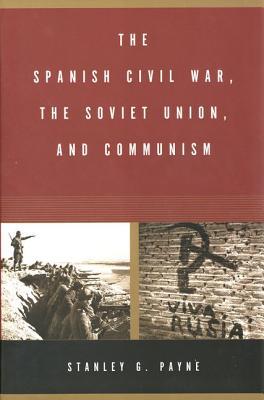The most respected historian specializing in the Spanish Civil War and the history of fascism, Stanley G. Payne has never hesitated to challenge received opinions in his field. Like his mentor and friend Burnett Bolloten, Payne has been properly critical of the Spanish Republic, the regime against which the Spanish military and much of the Spanish middle class rose up in revolt in 1936. Payne notes the murders and violence this government winked at; observes the failings of its leaders, Manuel Azaña, Largo Caballero, and Joan Negrín Lopez; and repeats Bolloten’s sarcastic remark at the expense of the Spanish Cortes’s first gathering after the civil war had commenced:
[I]t was a strange parliament because so many of the opposition leaders had either fled or been executed [in some cases before the uprising]. Nonetheless, the left Republican Polìtica would declare on December 2, that “the Republic confirms the existence of a flourishing and vigorous constitutional life,” even though mass arbitrary executions had not yet come to an end.
Payne is at least equally cold toward the Soviet Comintern and Stalin, who provided limited aid to the Republican side at an exorbitant price, using the 5,000 or so Soviet soldiers and Soviet agents sent to Spain partly to wipe out leftist revolutionary rivals and to force through, by the end of the conflict, Soviet-style political and social changes. He makes abundantly clear Stalin’s less-than-keen interest in winning the war, despite its being showcased (particularly after the arrival of Italian fascist forces and planes and pilots from Nazi Germany) as a struggle between the progressive left and fascism. For Stalin, Soviet intervention in Spain was a limited investment, intended to raise money through the sales of arms, underscore Soviet control of world communism, and increase influence over an economically backward Western European country. The eradication of Soviet enemies on the left was only an extension of what Stalin’s government was doing elsewhere. Stalin could not afford to be generous with manpower, since he was then involved in a war against Japan and still engaged in purging his own officer class. He would help Spain on the cheap, while trying to cut a deal with Nazi Germany. In optimal circumstances, he would leave it to volunteers (such as the American Abraham Lincoln Brigade) and to the Republic’s military and financial resources to repulse Gen. Francisco Franco and his Nationalist Legions.
Although Payne glorifies neither the Nationalist side nor the Soviet government, he lays the blame for losing the war on the Republic itself. Its wholesale killing of suspected enemies, brutalization of Catholic clergy, and stunning inability (apparent before July 1936) to maintain civil order contributed significantly to the Republic’s loss and explains why it became, with the ascension of the far-left Negrin government in May 1937, dependent on Soviet direction. One has to feel sorry for Stalin, stuck with those losers. In land, military equipment, financial resources, and entire branches of the armed services, the Republic had a decided advantage over the insurgents until well into the struggle.
Payne’s densely written work on the Soviet intervention in Spain differs from his related studies, which focus on the right. In his studies of fascism, the Spanish Falange, and the life of General Franco, though his sympathies were clearly with the European bourgeoisie, he showed the ability (what the Germans call Einfühlung) to empathize with the national revolutionaries grouped around José Prima de Rivera and the Spanish Falangists. His view of the Soviets is more clinical but also free of the ideological bitterness characteristic of other treatments of Stalin’s role in Spain. A series of testimonials, from George Orwell’s Homage to Catalonia to Ronald Radosh’s Spain Betrayed: The Soviet Union in the Spanish Civil War, has treated the Spanish Republic as a progressive democracy that was brought down by malevolent fascists and Stalinists. In recent years, neoconservatives have run with this view, while celebrating Radosh’s rediscovery of the Trotskyist and socialist party line on Spain. Significantly, POUM (the group that Orwell joined), founded in Barcelona in September 1936, was a Marxist-Leninist formation that declared itself for “democratic centralism” and established close working ties to the Trotskyist International Communist League. It is hard to grasp how these socialist revolutionaries would have protected constitutional freedom better than the conservative national side that triumphed in March 1939.
Harder still is to read Payne, or the earlier work done by Bolleten at the Hoover Institution, and cling to illusions of good democrats having been defeated by fascists. Although an authoritarian military leader who accepted German and Italian support, Franco did not create a Spanish equivalent of Nazi Germany or fascist Italy. Instead, he ended his caretaker rule by turning Spain into a constitutional monarchy. The Spanish Republic was neither a true constitutional regime nor a protector of life and property. It was complicit in organized murder against the right, including Spanish Catholic parliamentarians, and did nothing to control its Anarchist allies, who were killing property owners and churchmen. The most one could say in its defense is that not all of its leaders were equally contemptible. The president at the time of the uprising, Manuel Azaña, hoped to preserve parliamentary amenities but was colossally inept in accomplishing that—or anything. With due respect to Radosh, there was nothing the West, or even the Soviets, “betrayed” by not riding to the Republic’s rescue.
[The Spanish Civil War, the Soviet Union, and Communism, by Stanley G. Payne (New Haven: Yale University Press) 377 pp., $35.00]

Leave a Reply